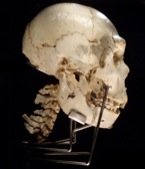Middle Pleistocene
Homo heidelbergensis and the muddle in the middle
10/10/09 19:45 Filed in: Palaeoanthropology

At the conference, much attention was focused on the Middle Pleistocene "muddle in the middle" [3], particularly the role of Homo heidelbergensis in hominin evolution. While H. heidelbergensis possesses both archaic and derived traits intermediate between H. erectus and later members of the Homo genus, it lacks uniquely derived traits or autapomorphies, which are a prerequisite for defining a species.
H. heidelbergensis has traits that have been interpreted as nascent Neandertal autapomorphies, leading some researchers to propose that there was a continuous evolution of Neandertals [4-6]. This accretion model would make H. heidelbergensis a chronospecies on the continuum of the Neandertal lineage, a view championed by Jean-Jacques Hublin. The accretion model proposes that Neandertals evolved by anagenesis, i.e. non-branching evolutionary change. Read More...
0 Comments
